Lobular Inflammation: An In-Depth Analysis
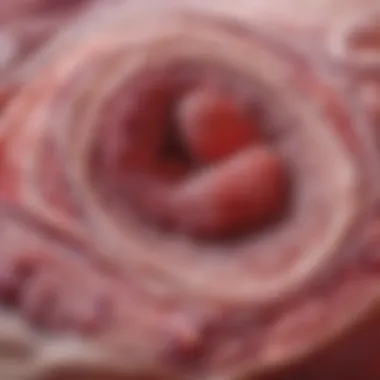
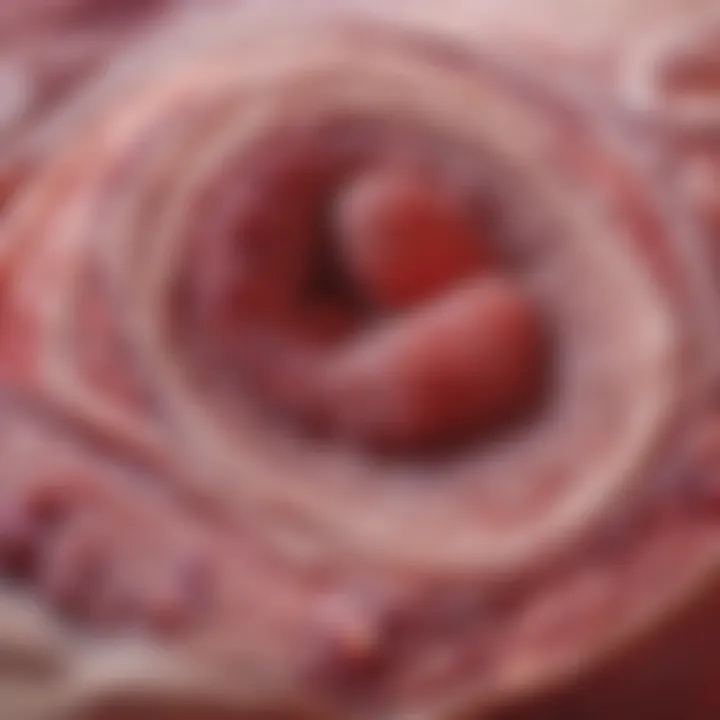
Intro
Lobular inflammation presents a unique challenge in medical science, often seen in various diseases involving the lungs and liver. Understanding this condition is crucial as it influences both diagnosis and treatment plans. The inflammatory processes are localized within lobules, making the examination of this pathology essential for advancing patient care. Researchers and clinicians must focus on the intricacies involved in lobular inflammation, from its etiology to the therapeutic approaches available.
Recent Advances
Latest Discoveries
Recent studies in lobular inflammation indicate significant advancements in understanding the underlying mechanisms. Researchers have identified various cytokines and chemokines that play a vital role in the inflammatory process. Specifically, interleukin-6 (IL-6) and tumor necrosis factor-alpha (TNF-alpha) are emerging as key players in determining the severity of inflammation within the lobules. The interaction between these molecules results in a complex network influencing cellular behavior in affected organs.
Additionally, insights into genetic predispositions are reshaping the perspective on lobular inflammation. Genetic markers linked to inflammatory responses are being investigated to predict susceptibility to related diseases. This progress suggests a more personalized approach to diagnosis and treatment, tailoring therapies according to genetic profiles.
Technological Innovations
Technological advancements have also contributed to the study of lobular inflammation. Imaging techniques such as high-resolution computed tomography (HRCT) and magnetic resonance imaging (MRI) offer non-invasive means to visualize the inflammatory changes in the lungs and liver. These innovative approaches enable early detection and assessment of disease progression.
Moreover, artificial intelligence (AI) is playing a growing role in analyzing medical images, improving diagnostic accuracy. Machine learning algorithms are being developed to identify patterns indicative of lobular inflammation, enhancing the speed and precision of evaluations.
Methodology
Research Design
A thorough understanding of lobular inflammation demands rigorous research designs. Researchers often employ longitudinal studies to capture the progression of the condition over time. This design allows for a comprehensive view of how lobular inflammation develops and responds to interventions.
Data Collection Techniques
Conversely, data collection for studies may include various techniques. One prominent method is utilizing biopsies, which provides detailed information on the cellular characteristics of the inflamed lobules. Additionally, serum markers are frequently analyzed to gauge systemic inflammation. Surveys and interviews with patients offer qualitative insights, supplementing the quantitative data obtained from clinical tests.
Lipular inflammation is not just a clinical finding, but a critical indicator of several underlying pathologies. Effective management requires an in-depth understanding of its mechanisms and implications.
In summary, lobular inflammation presents a multifaceted challenge that requires ongoing research and exploration. By integrating advancements in technology with a strong research foundation, a deeper understanding of its etiology and consequences will emerge, benefiting patients and healthcare providers alike.
Prologue to Lobular Inflammation
Lobular inflammation is a critical component in understanding various medical conditions, especially those affecting the lungs and liver. This form of inflammation specifically targets the lobules, small subdivision of organs, which can lead to significant health implications. By delving into this subject, we can better comprehend its pathological processes, the underlying causes, and the various treatment approaches available. As an interstitial pathology, lobular inflammation requires careful consideration due to its complex interactions with both infectious and non-infectious agents.
Understanding lobular inflammation is vital for several reasons. First, it lays the foundation for recognizing symptoms and diagnostic criteria, which are essential for effective patient management. Second, this topic reinforces the significance of timely intervention in mitigating complications that arise from chronic inflammation. The insights gained from this exploration inform both clinical practice and future research opportunities, encouraging advancement in treatment strategies.
Definition and Overview
Lobular inflammation refers to a localized inflammatory response within the lobules of various organs. It is marked by the infiltration of immune cells, which can cause tissue damage and functional impairment. The term encompasses a wide range of inflammatory processes, often manifested in conditions such as lobular pneumonia, lobular hepatitis, and others.
In its essence, lobular inflammation can be a response to various stimuli, including pathogens, toxins, or autoimmunity. The body mounts an immune response that is characterized by swelling, redness, and cellular repair processes. Depending on the underlying cause, the severity and outcome of this inflammation can vastly differ.
Significance in Clinical Practice
In clinical practice, recognizing lobular inflammation is crucial for accurate diagnosis and treatment. Medical professionals often observe symptoms such as cough, fever, jaundice, or respiratory distress, which may indicate lobular involvement. Through a thorough patient history and physical examination, clinicians can identify potential causes and tailor their approach accordingly.
Incorporating diagnostic imaging techniques, such as CT scans or MR imaging, allows for better visualization of the affected lobules, enhancing diagnostic accuracy. Furthermore, histopathological assessment via biopsy can provide definitive evidence of lobular inflammation, guiding effective treatment plans.
Understanding the nuances of lobular inflammation also aids in determining prognosis. Factors such as the extent of inflammatory damage and the presence of underlying health conditions significantly influence patient outcomes. Therefore, knowledge of this topic not only supports initial diagnosis but also informs ongoing care strategies and rehabilitation efforts.
"By understanding lobular inflammation, we empower healthcare providers to improve patient management and clinical outcomes."
Etiology of Lobular Inflammation
The etiology of lobular inflammation is essential for understanding the underlying factors contributing to this pathology. Identifying the root causes enables healthcare professionals to tailor interventions effectively. By examining both infectious and non-infectious origins, one can gain insight into management strategies and potential outcomes. This section provides a detailed exploration of the variances in etiology, which is critical for clinical application and further research.
Infectious Agents
Bacterial Infections
Bacterial infections represent a significant aspect of lobular inflammation. Specific bacteria can infiltrate organ lobules, leading to localized inflammatory responses. A key characteristic of bacterial infections is their ability to provoke a strong immune response. This makes them a prominent consideration in the context of lobular inflammation within this article.
One unique feature of bacterial infections is their diverse range of pathogenic mechanisms. For example, pathogens such as Staphylococcus aureus can cause necrotizing lobular pneumonia, while Mycobacterium tuberculosis may lead to granulomatous inflammation. The advantages of discussing bacterial infections in this article lie in their well-documented clinical outcomes and treatment pathways. However, the challenges include potential antibiotic resistance, which complicates management .
Viral Infections
Viral infections can also initiate lobular inflammation. These infections often result in systemic inflammation, affecting the function of organs such as the liver and lungs. A notable characteristic of viral infections is their capacity to evade the immune system, making them a relevant area of focus in this article.
Unique to viral infections is their ability to remain dormant during specific life cycles, leading to chronic inflammation. For instance, the hepatitis B virus may result in chronic liver inflammation and scarring. Understanding the implications of viral infections helps contextualize pathology and guides future treatments. The disadvantage, however, includes variability in patient responses and potential for significant long-term health impacts.
Fungal Infections
Fungal infections are another important contributor to lobular inflammation. These infections can cause significant damage and lead to severe inflammatory responses. A key characteristic of fungal agents is their strategic adaptations to persist in host tissues, often leading to chronic conditions. This makes them a beneficial component of discourse in this article.
Fungi such as Aspergillus species can cause allergic fungal sinusitis, demonstrating how these organisms can impact the lobular structure of various systems. The unique feature of fungal infections is their complex interaction with the host’s immune system, resulting in a diverse array of pathogenic responses. However, their treatments can often be limited, as many antifungal agents may not penetrate deeply into infected tissues effectively.
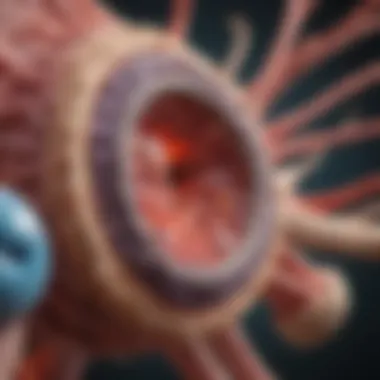
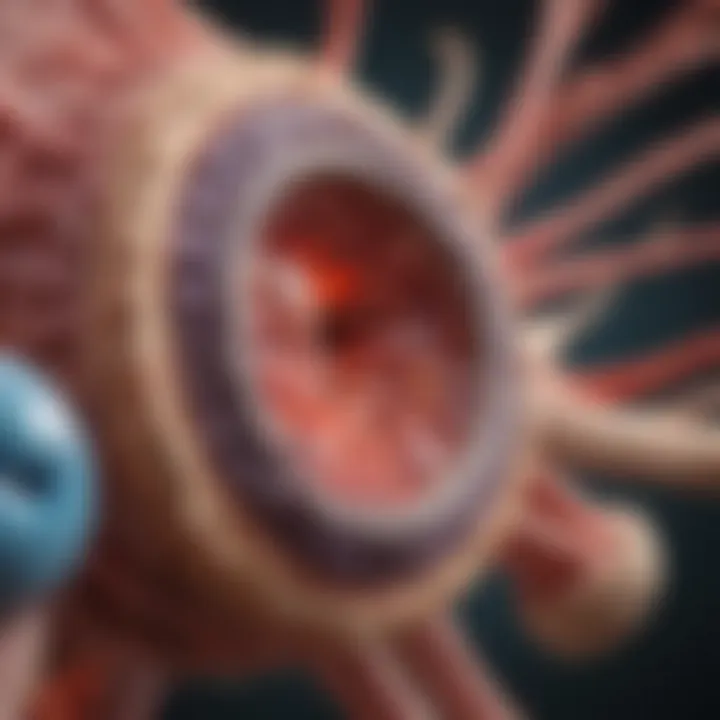
Non-Infectious Causes
Autoimmune Disorders
Autoimmune disorders are crucial in contributing to lobular inflammation. In these conditions, the immune system erroneously targets and attacks healthy tissues, leading to inflammation. A key characteristic is the chronic nature of these disorders, which can perpetuate inflammation for extended periods. This makes autoimmune disorders a prominent topic in this article.
The unique feature of autoimmune diseases lies in their heterogeneous presentations. For example, lupus can cause diffuse inflammation, while rheumatoid arthritis may affect the lung lobules directly. Understanding the mechanisms of these disorders may provide insights into novel treatment pathways, though challenges remain in effectively managing these often multifaceted conditions.
Environmental Factors
Environmental factors play a significant role in inducing lobular inflammation. Exposure to pollutants, allergens, and toxins can lead to inflammatory responses in various organs. One key characteristic of environmental triggers is their widespread nature, making them a relevant subject in this discussion.
Unique to environmental factors is their ability to interact with genetic predispositions—leading to varying levels of inflammation among individuals. Understanding these interactions can guide preventive measures, although establishing direct causation often proves difficult. This complexity can be both a benefit and a disadvantage, as environmental factors often require holistic and community-centered approaches to management.
Metabolic Disorders
Metabolic disorders also contribute significantly to lobular inflammation. These conditions often result in altered biological pathways, leading to inflammation in specific organ systems. A primary characteristic is their association with obesity and insulin resistance, which commonly aggravate lobular inflammation. This makes metabolic disorders an important consideration in this article.
The unique features of metabolic disorders include their systemic effects that can lead to multi-organ involvement. For instance, non-alcoholic fatty liver disease is closely related to metabolic syndrome and causes inflammation in liver lobules. The advantages of considering these disorders encompass a growing recognition of their prevalence. However, managing these conditions can be challenging due to lifestyle modifications often required for effective treatment.
Pathophysiology of Lobular Inflammation
Understanding the pathophysiology of lobular inflammation is essential for comprehending how this condition impacts organ function and patient health. This section delves into the cellular mechanisms driving inflammation, the dynamic interactions of mediators, and the consequential effects on tissue structure. Highlighting these aspects is critical for developing effective diagnostic and therapeutic strategies.
Cellular Mechanisms
Role of Immune Cells
The role of immune cells in lobular inflammation is paramount. These cells, including neutrophils, macrophages, and lymphocytes, actively participate in the inflammatory response. They migrate to the site of inflammation, where they help to eliminate the offending agents.
One key characteristic of immune cells is their ability to recognize and respond to pathogens or damaged tissues. This capability is vital in controlling the inflammatory process and preventing further tissue damage. The diversity of immune cell types allows for a tailored response, which can be beneficial in clearing infections but may also lead to excessive inflammation in some instances.
A unique feature of immune cells is their varied response based on the local environment. They can adapt their functions depending on the signals received from cytokines and other mediators. This adaptability can be an advantage in quickly addressing infection but may also have disadvantages, leading to chronic inflammation if signals become persistently activating.
Cytokine Dynamics
Cytokine dynamics play a crucial role in the regulation of lobular inflammation. Cytokines are signaling proteins released by immune cells that facilitate communication between them. They regulate the intensity and duration of inflammatory responses. A prominent characteristic of cytokines is their dual role; they can promote or resolve inflammation, depending on the context.
This characteristic is beneficial for maintaining homeostasis and preventing excessive damage to tissues. However, the unique advantage of cytokine networks is that they can become dysregulated during lobular inflammation, leading to either chronic inflammation or tissue destruction.
Inflammatory Mediators
Inflammatory mediators encompass a variety of substances such as histamines, prostaglandins, and leukotrienes, which are involved in sustaining the inflammatory response. Their role is significant as they control the vascular and cellular responses in the inflamed area.
A key characteristic of inflammatory mediators is their ability to amplify the inflammatory response. They ensure a rapid reaction to injury or infection, which is crucial for early containment of harmful agents. However, their unique feature is the potential for overactivity, leading to detrimental effects such as tissue injury or systemic inflammatory responses.
Impact on Tissue Architecture
Inflammation significantly alters tissue architecture, which affects organ function. The physiological structure of lung and liver lobules is particularly vulnerable. Understanding these changes is vital for diagnosing and managing lobular inflammation.
Scarring and Fibrosis
Scarring and fibrosis are serious consequences of prolonged lobular inflammation. When inflammation persists, it stimulates fibroblast activity, leading to excess collagen deposition. This can disrupt normal tissue architecture, resulting in impaired organ function. A key feature of scarring is that it may not present immediate symptoms, making its detection challenging in early stages.
Fibrosis can be considered beneficial in acute settings, as it helps in tissue repair and preventing further injury. However, the long-term disadvantage is that it often leads to irreversible damage and functional impairment of the organ.
Hyperplasia
Hyperplasia refers to the increase in cell numbers in response to inflammation. During lobular inflammation, it can be a compensatory mechanism aimed at restoring normal tissue function. A key characteristic is that hyperplasia can indicate ongoing inflammation, especially if it becomes extensive.
While hyperplasia serves to increase tissue turnover and repair, its unique disadvantage is that it can lead to abnormal growth patterns, which may contribute to dysplastic changes and increase the risk of malignancies.
Tissue Repair Mechanisms
Tissue repair mechanisms are crucial for recovery from lobular inflammation. These processes involve a series of stages including hemostasis, inflammation, proliferation, and remodeling. A key characteristic of tissue repair is its ability to restore normal architecture, minimizing functional loss.
However, it is essential to note that these repair mechanisms can be inadequate or skewed in chronic inflammation. This imbalance may result in incomplete healing, contributing to sustained inflammation and ongoing tissue damage.
Understanding the pathophysiology of lobular inflammation is not just an academic exercise; it holds practical implications for patient care and treatment strategies.
In summary, the pathophysiology of lobular inflammation demonstrates the complex interplay of cellular mechanisms and tissue alterations. Unraveling these layers is critical for developing targeted interventions and optimizing patient outcomes.
Diagnostic Approaches for Lobular Inflammation
Effective diagnosis is critical for identifying and managing lobular inflammation. A systematic approach to diagnosis helps clinicians delineate the underlying causes. In this section, we will explore three key areas: Clinical Evaluation, Imaging Techniques, and Histopathological Assessment. Each method provides unique insights and forms a comprehensive framework for understanding lobular inflammation.
Clinical Evaluation
Patient History
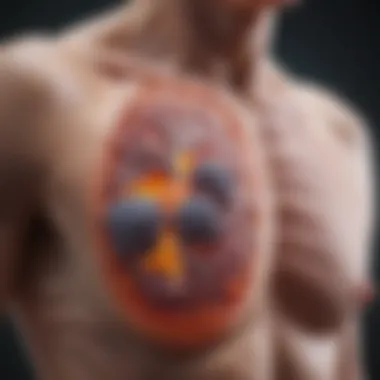

A thorough patient history is fundamental in diagnosing lobular inflammation. This involves collecting detailed information on symptoms, medical history, and lifestyle factors. The patient's narrative often reveals potential triggers of inflammation, such as recent infections or environmental exposures. The key characteristic of patient history is its comprehensive nature. It allows healthcare providers to form a conjecture on possible causes of inflammation. This significance is why it is a beneficial choice for this article. The unique feature of patient history lies in its capacity to guide clinical decision-making. However, reliance on patient recall can introduce bias or inaccuracies.
Physical Examination
Physical examination serves as a direct method to assess the patient's health status. During this process, clinicians can observe signs of inflammation, such as swelling or tenderness. The key characteristic of physical examination is its immediacy; it provides real-time data on the patient's condition. This approach is recognized as a popular choice for diagnosing inflammation. A distinct feature of this evaluation method is that it can yield immediate insights into severity and distribution of the lobular inflammation. Despite its many advantages, it does not replace more advanced diagnostic techniques, making it a step in a larger diagnostic process.
Symptomatology
Understanding symptomatology is essential to linking clinical presentations with lobular inflammation. Symptoms may range from respiratory issues in lung inflammation to hepatomegaly in liver inflammation. The key characteristic of symptomatology is its specificity. Identifying particular symptoms enables clinicians to differentiate between various types of lobular inflammation. This makes symptomatology a beneficial choice for this article. Its unique feature includes the broad spectrum of symptoms that may be interdependent. However, it is important to recognize that symptoms can be nonspecific and may overlap with other conditions.
Imaging Techniques
Radiography
Radiography, particularly chest X-rays, plays a pivotal role in visualizing lobular inflammation. It provides a preliminary assessment of lung conditions and identifies potential areas of concern. The key characteristic of radiography is its speed; images can be obtained quickly, which is vital in acute settings. This modality is a beneficial choice for this article due to its accessibility and low cost. A unique feature of radiography is its ability to reveal structural changes in lobes, such as consolidation or nodules. However, it may not provide definitive information about the extent of inflammation.
CT Scans
Computed Tomography (CT) scans offer a more detailed look at lobular inflammation than standard radiography. They can depict the intricate architecture of organs and assist in identifying localized areas of inflammation. The key characteristic of CT scans is their resolution. They provide cross-sectional images, which help ascertain the severity and extent of lobular inflammation. It is a beneficial choice due to accurate imaging capabilities. The distinct feature of CT scans is their ability to guide clinical management decisions. However, increased radiation exposure is a concern, which clinicians must weigh against the benefit of detailed information.
MR Imaging
Magnetic Resonance Imaging (MRI) is another advanced technique useful in the assessment of lobular inflammation. MRI is particularly beneficial in soft tissue evaluation, such as in liver conditions. The key characteristic of MRI is its non-invasive nature, as it does not use radiation. This uniqueness makes MRI a valuable choice in this article, especially for repeated assessments. Additionally, it provides detailed soft tissue contrast, allowing visualization of edema and inflammatory processes. However, the extended duration and high cost of MRI scans can pose challenges in urgent scenarios.
Histopathological Assessment
Tissue Biopsy Techniques
Tissue biopsy techniques are crucial for a definitive diagnosis of lobular inflammation. These methods allow for direct sampling of affected tissue, which can be analyzed microscopically. The key characteristic of tissue biopsy is its accuracy in providing pathological context. It is a beneficial choice for this article, offering clear identification of inflammatory changes. A unique feature of biopsy techniques is that they can reveal distinct cellular characteristics indicative of specific causes. However, they can be invasive and carry risk of complications, which must be considered.
Microscopic Examination
Microscopic examination of biopsy samples is vital for the diagnosis of lobular inflammation. It allows pathologists to assess the cellular architecture and identify inflammatory infiltrates. The key characteristic of microscopic examination is its detail. This level of scrutiny makes it a popular choice for elucidating the nature of the inflammation. A distinct feature of this examination is its ability to differentiate between types of inflammatory cells. Nevertheless, the interpretation of histological findings requires significant expertise.
Staining Techniques
Staining techniques complement microscopic examination by enhancing visualization of specific cellular components. Different stains can highlight cellular morphology, pathogen presence, and the extent of inflammation. The key characteristic of staining techniques is their specificity, allowing for identification of distinct cell types. This makes them a beneficial choice for this article, as they contribute to diagnosis clarity. A unique feature of staining techniques is their ability to provide diagnostic clues that are not visible in unstained samples. However, improper staining can lead to misinterpretation, emphasizing the need for careful application.
Management and Treatment Strategies
Management and treatment strategies for lobular inflammation are crucial in addressing both the underlying causes and the symptomatic relief associated with this condition. Effective management can lead to improved patient outcomes, greater quality of life, and slow the progression of any resulting chronic disorders. Careful consideration must be given to the comprehensive approach to treatment, incorporating both pharmacological and non-pharmacological interventions.
Pharmacological Interventions
Anti-inflammatory Agents
Anti-inflammatory agents play a pivotal role in managing lobular inflammation. They are designed to reduce inflammation and mitigate its detrimental effects on tissues. The key characteristic of these agents is their ability to suppress the inflammatory response. This makes them a beneficial choice in the management of lobular inflammation, especially when rapid relief is necessary.
The unique feature of anti-inflammatory agents lies in their mechanism of action: they inhibit inflammatory mediators and alter cellular signaling pathways associated with inflammation. However, while these agents can provide substantial benefits, they may also lead to adverse effects such as gastrointestinal disturbances or cardiovascular risks, which necessitates careful patient selection and monitoring.
Immunosuppressants
Immunosuppressants are another category of pharmacological intervention used in lobular inflammation, primarily when the underlying cause involves an overactive immune response. Their fundamental role is to dampen the immune system, thus preventing further tissue damage caused by unchecked inflammatory processes. This makes them a popular choice for conditions where autoimmunity is a significant factor.
These drugs often exhibit a unique property: they can provide long-term management of chronic inflammatory conditions. However, their use carries risks, including an increased likelihood of infections and potential organ toxicity, making close medical supervision essential.
Antibiotics
Antibiotics are critical in treating cases of lobular inflammation where an infectious etiology is identified. The main aspect of antibiotics is their ability to target bacterial pathogens responsible for the inflammation. They are often considered a beneficial option in scenarios involving bacterial infections such as pneumonia or abscess formation in the lungs or liver.
A unique characteristic of antibiotics is their specificity to bacteria, which aids in tailoring treatment. However, inappropriate use can lead to antibiotic resistance, escalating the problem of effective treatment and making their prudent use vital in clinical settings.
Non-Pharmacological Approaches
Lifestyle Modifications
Lifestyle modifications are essential in the holistic management of lobular inflammation. Changes in diet, exercise, and stress management can positively influence the inflammatory process. These modifications are often recognized for their role in supporting overall health, which can enhance the effectiveness of medical treatments.
A distinguishing feature of lifestyle modifications is their accessibility and non-invasive nature. However, the disadvantage lies in the variability of individual responses and the need for sustained commitment from patients to see significant benefits.
Rehabilitation Programs
Rehabilitation programs are integral in the recovery process, particularly in cases of severe lung or liver impact. These programs are tailored to enhance respiratory function, improve physical endurance, and foster overall well-being. The key characteristic of rehabilitation is its focus on restoring function and optimizing health after injury or surgery.
A unique aspect of rehabilitation programs is their structured approach, utilizing physical therapy and occupational therapy. However, these programs might face challenges, including patient adherence and variability in response to different rehabilitation techniques.
Patient Education
Educating patients about lobular inflammation and its management is fundamental to achieving optimal outcomes. Patient education involves informing individuals about the condition, treatment options, and lifestyle adjustments to improve their health. This approach empowers patients and aids in adherence to prescribed therapies.


The key advantage of patient education is the facilitation of informed decision-making. Unique to this approach is the development of a collaborative relationship between patients and healthcare providers. However, the effectiveness of education can be limited by factors such as health literacy and access to resources, which must be addressed for optimal implementation.
Prognosis and Outcomes
Understanding the prognosis and outcomes of lobular inflammation is essential for managing patient care effectively. This section outlines significant factors that can influence the prognosis of patients suffering from this condition. By exploring these aspects, healthcare professionals can better tailor their interventions, ultimately improving patient outcomes and overall health.
Factors Influencing Prognosis
Severity of Inflammation
The severity of inflammation plays a crucial role in determining the prognosis of lobular inflammation. The intensity of the inflammatory response can indicate how much damage has occurred to the affected organs. A key characteristic of severe inflammation is the extent of tissue infiltration by immune cells. This infiltration can lead to more significant structural changes in the organ, making recovery more complex. Understanding the severity allows clinicians to gauge the likely recovery pathways and set realistic expectations for patients. However, if the inflammation is acute, there may be favorable outcomes with timely interventions.
Underlying Health Conditions
Underlying health conditions are another pivotal factor that impacts prognosis. Conditions such as diabetes, chronic respiratory disorders, and cardiovascular diseases can complicate the management of lobular inflammation. They can exacerbate the inflammatory response, leading to poorer outcomes. The coexistence of these diseases often hinders the body’s ability to heal efficiently. Hence, addressing these underlying conditions can be beneficial for recovery. Educating patients about their health status is crucial for effective management.
Timeliness of Intervention
Timeliness of intervention significantly influences the prognosis of lobular inflammation. Early detection and management can prevent prolonged inflammatory responses which may lead to chronic conditions. The key characteristic of timely intervention is the swift decision-making process by healthcare professionals. Prompt treatment often results in better outcomes, reducing the risk of complications. However, delayed treatment can contribute to lasting damage, making timely care a critical factor in achieving positive results.
Long-term Complications
Long-term complications can arise from unresolved lobular inflammation, affecting the patient’s quality of life and health status over time. Different complications may develop based on various influencing factors discussed previously.
Chronic Disease Progression
Chronic disease progression is a significant aspect of the long-term outlook for individuals with lobular inflammation. If the inflammation leads to sustained organ damage, it can result in chronic diseases like pulmonary fibrosis or cirrhosis. This aspect is important because it highlights the necessity of continuous monitoring even after acute episodes. The unique feature of chronic progression demands ongoing treatment and lifestyle adjustments to manage symptoms. Failure to address these issues can lead to serious health declines.
Quality of Life Considerations
Quality of life considerations are vital when discussing prognosis and outcomes for patients experiencing lobular inflammation. The chronic nature of the condition can severely affect daily activities and mental health. The key characteristic of quality of life is how it encompasses physical, emotional, and social well-being. A thorough understanding of this can influence treatment decisions and lifestyle modifications that may improve patient satisfaction. Incorporating patient feedback into management plans can create a more holistic approach to care, impacting long-term outcomes positively.
Decisions on End-of-Life Care
Decisions on end-of-life care are deeply intertwined with the prognosis of patients with advanced lobular inflammation or related complications. This consideration is crucial for patients and families facing difficult choices. The key characteristic in these situations often involves a focus on dignity and comfort. The unique feature of end-of-life planning is that it allows patients to express their wishes regarding care preferences. Involving multidisciplinary teams can ensure that care aligns with the patients' values and needs, potentially alleviating some of the stress associated with serious health conditions.
"Understanding prognosis is not just about outcomes; it's essential in guiding comprehensive patient care."
In summary, the prognosis and outcomes associated with lobular inflammation depend on several interconnected factors, including severity, underlying conditions, and timely intervention. Recognizing potential long-term complications enriches the conversation surrounding patient management and care planning.
Current Research Trends
Research on lobular inflammation is crucial due to its implications in various diseases affecting lungs and liver. Understanding the latest developments helps pinpoint effective management strategies and enhances patient care. Current trends focus on several areas that can shift perspectives in diagnosis and therapy for lobular inflammation. The progress made in recent years underscores the need for continual exploration in this field.
Recent Studies on Etiology
Recent investigations into the etiology of lobular inflammation reveal significant insights into its diverse causes. Studies show that both infectious and non-infectious agents can instigate these inflammatory responses.
- Infectious Agents: Bacterial and viral organisms often trigger lobular inflammation. Pathogens such as Streptococcus pneumoniae and Hepatitis viruses act as primary culprits. Understanding the role of these agents can guide therapeutic interventions and diagnostics.
- Non-Infectious Causes: Autoimmune disorders like lupus and environmental elements, such as pollution, also contribute to lobular inflammation. Recognizing these factors is vital in patient history assessment and guiding treatment plans. Recent research emphasizes the intricate balance between genetic predispositions and environmental triggers in the onset of lobular inflammation.
Innovations in Diagnostic Techniques
Noteworthy advancements in diagnostic techniques have emerged. These innovations enhance the accuracy of identifying lobular inflammation and differentiate between various etiologies.
- Imaging Technologies: Developments in imaging, particularly with Magnetic Resonance Imaging (MRI), allow for in-depth visualization of lobular structures. The precision of MRI surpasses traditional imaging methods in depicting inflammatory processes.
- Biomarkers: The identification of specific biomarkers is revolutionizing diagnostics. For example, elevated cytokine levels can indicate the presence and severity of inflammation. Continued research aims to solidify these biomarkers' roles, leading to more targeted interventions.
Emerging Therapies and Trials
The landscape of treatment for lobular inflammation is changing with promising therapeutic strategies. Clinical trials are exploring novel agents and methodologies to address this condition.
- Targeted Therapies: New treatments aim to modulate the immune response effectively. For instance, biologics targeting specific pathways in the inflammatory process are currently under investigation. These therapies could provide tailored approaches based on individual patients' needs.
- Regenerative Medicine: Innovations in regenerative medicine may offer future avenues for treatment by promoting tissue repair and restoration, particularly relevant in chronic cases of lobular inflammation.
The field's rapid evolution reflects ongoing dedication to enhancing outcomes for those affected. By synthesizing knowledge across various research fronts, clearer pathways for managing lobular inflammation are emerging.
Culmination
The conclusion of this article serves as a vital element, summarizing the intricate aspects of lobular inflammation. Throughout the sections, several specific elements have been discussed, offering a comprehensive view of this condition. Understanding lobular inflammation is crucial due to its relevance in various medical contexts such as respiratory and hepatic diseases.
Key benefits of properly addressing this topic include:
- Enhanced patient management: By recognizing the signs and symptoms of lobular inflammation, healthcare professionals can enact timely interventions, significantly improving patient outcomes.
- Informed treatment decisions: Knowledge of treatment strategies enables clinicians to prescribe appropriate therapies, which can mitigate inflammation and prevent further tissue damage.
- Future research opportunities: This area still presents many questions and complexities, providing fertile ground for academic inquiry and potential innovations in management.
In reflecting on the importance of lobular inflammation, it becomes evident that its effects can extend beyond immediate symptoms. There are long-term health implications that can affect patient quality of life. Therefore, the synthesis of information presented throughout this article illustrates that lobular inflammation is not only a focal point for immediate treatment but also a critical subject for ongoing research.
Summary of Key Points
- Definition and Overview: Lobular inflammation refers to localized inflammatory processes primarily found in organs like the lungs and liver.
- Etiology: This inflammation can be caused by a variety of infectious agents and non-infectious triggers, including autoimmune disorders and environmental factors.
- Pathophysiology: Understanding the underlying cellular mechanisms and how they impact tissue architecture is essential for grasping the full scope of lobular inflammation.
- Diagnostic Approaches: Clinical evaluations alongside advanced imaging techniques and histopathological assessments are necessary for accurate diagnosis.
- Management Strategies: Treatment can involve pharmacological and non-pharmacological interventions tailored to each patient's unique situation.
- Prognosis and Outcomes: Various factors affecting prognosis include the severity of inflammation and the identification of underlying health issues.
- Current Research Trends: Ongoing studies and trials are vital for expanding understanding and refining therapeutic approaches.
Future Directions in Research
Future research on lobular inflammation is poised to explore several promising avenues:
- Mechanistic studies: Delving deeper into the cellular processes involved in lobular inflammation will clarify pathogenic pathways, which could lead to targeted therapies.
- Innovative diagnostic tools: Advancements in imaging and biomarker identification could enhance diagnostic accuracy, allowing for earlier intervention.
- Therapeutic innovations: Exploring new compounds or treatment modalities may provide alternatives to existing therapies, improving patient outcomes in refractory cases.
- Longitudinal studies: These studies can yield insights into the progression of lobular inflammation over time, as well as its long-term effects on health.
In summary, this article highlights the multifaceted nature of lobular inflammation and underscores the importance of continuing research to better understand and manage this condition.















